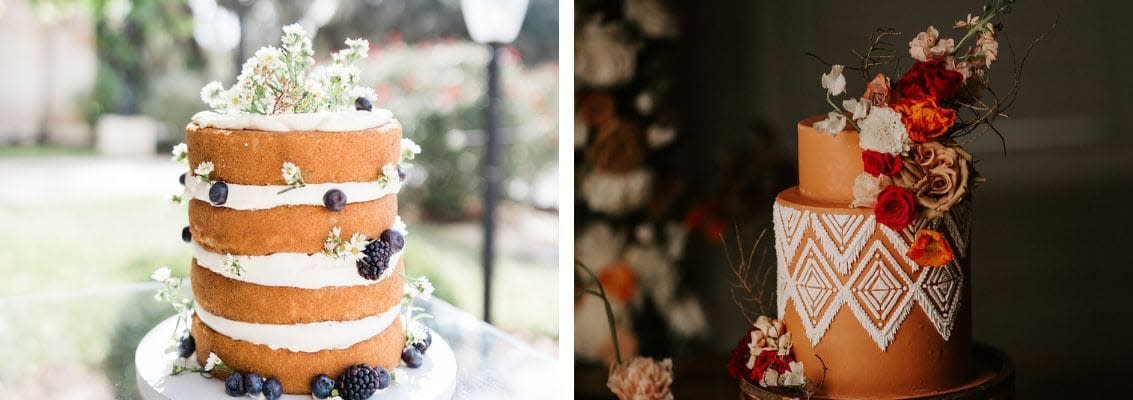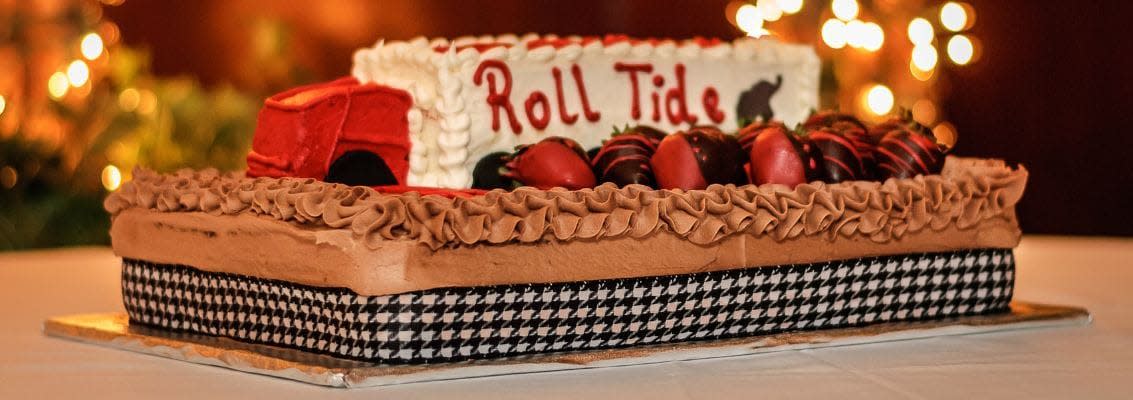Wedding cakes have been a part of the ritual celebration since the ancient Romans ended their wedding rites with a sconelike wheat or barley cake being broken over the bride’s head to ensure good luck and fertility.
Later, when the Romans invaded Britain in A.D. 43, they brought their bread-breaking tradition with them. By the Middle Ages, the English created the precursor of the modern-day cake by stacking buns and scones as high as possible and having the couple try to kiss over it without it toppling. According to legend, if they were successful in that smooch, they would have good fortune and many children.
They rest, as they say, is history and wedding cakes have evolved into the magnificent, elegant confections we know today.
With the COVID-19 pandemic in 2020, most couples were forced to cancel, postpone or greatly modify their wedding plans, which included, in many cases, altering their menu—starting with the wedding cake.
“Wedding cakes have always been a part of a reception, but for the past few years, the cakes have been smaller and more of a ceremonial wedding cake,” said Cristina Calvert, Founder of Cristina Calvert Weddings.
Now, as the world—and weddings—rebounds, the traditional mainstay of the nuptial feast is back on the menu, with some changes.
“We have seen post-COVID cakes go bigger and more over the top with more details that are incorporated,” said JoAnn Gregoli, Founder of Elegant Occasions by JoAnn Gregoli. “Couples want the cake to tell a story about who they are. There is more attention to the detail of the cake so that it matches the design of the wedding and helps define the couple.”
According to The Knot, the average cost of a wedding cake in 2022 was $510, up 2% compared to 2021. However, today’s wedding cake prices have dropped from what they were in 2018, when the cost was around $550.
“Grand and many tiered cakes may be more of a thing of the past,” noted Priscilla Rose, Founder of Priscilla Rose Events. “The cakes themselves are not usually the focus anymore, but the details surrounding them are, instead. For example, a floral structure behind the cake, the dresser or structure holding it, etc.
The Cake Evolution
Oniki Hardtman, Founder of Oh Niki Occasions, says cakes trends are always evolving. Although cakes have been used in the past to showcase a couple’s personality or the theme of the wedding, these days, the designs can be quite elaborate.
“Cakes are looking more like modern works of art and truly a showpiece for the reception with elegant execution that makes you almost not want to cut it,” Hardtman said.
Calvert agrees, noting that couples are celebrating big and making the wedding cake more celebratory.
“They blend the floral elements, the colors, and any patterns or details to become a statement piece and work of art,” she said.

Design Trends
White and ivory cakes are still the most predominant based on tradition, ease and availability, according to Hardtman. She notes that if cake is included with the catering contract, then white or ivory buttercream is typically included.
“However, color cakes and heavily adorned cakes are surely making a big statement,” Hardtman said.
“Most cakes we see are white and color is coming from the flowers or fruit,” added Rose. “Fresh flowers and fruits like blackberries, currants, cherries are popular extras.”
Some weddings are exhibiting a resurgence in retro wedding cakes, including intricate designs, rosettes and piping such as the ornate Lambeth decorating technique originated in the United Kingdom in the 1930s, Calvert said.
And what about the cake-tasting?
Selecting the special flavor of cake and frosting involves teamwork and couples are often encouraged to have family members pitch in.
“I always suggest to my couples and their families to try the cakes together and leave a little for the end,” Calvert said. “That way, if you are deciding between a few flavors, you’ll have a little left over to sample again. The icing is also very important to try—there’s buttercream and then fondant.”
Rose notes that fondant is not as popular as it once was, with couples preferring buttercream frosting, and flavors for the actual cake, such as cookies and cream or cherry.

Don’t Forget the Groom
In addition to the traditional wedding cake, some planners are still seeing groom’s cakes, representing the groom and his tastes and hobbies.
“Groom’s cakes are still being used, as brides want to gift the groom with a surprise cake that is all about his hobbies,” Gregoli said.
A groom’s cake is a way to offer different flavors of cake and add a festive and personalized element to the dessert table, Calvert noted.
Beyond the Traditional
In addition to the signature wedding cake, planners are seeing that other dessert options are being offered to guests.
“There is something timeless and classic about the wedding cake being the sweet ending to the night,” Calvert said. “The wedding cake is the statement dessert, but there are usually additional bite-size desserts offered to the guests. It's very common to have grab-and-go dessert bites so guests can have something sweet but get back on the dance floor.”
From doughnuts and ice cream trucks to cake-to-go, couples are looking for ways to make their big day extra sweet.
“Dessert Bars are more popular than ever,” Hardtman said. “It seems that suddenly everyone has a sweet tooth, and couples are leaning into that notion to provide guests an array of sweet treats to choose from. This is also a great way to highlight local favorites based on where the couple is from, where they met or where they wed.”
And some are even going so far as to not have a cake at all, or they make it a to-go item.
“Some couples are nixing cake altogether and offer late-night bites as a savory option for guests and maybe sending them home with a sweet favor bag instead,” Rose noted. “Cake-to-go has been a cute add-on, as these couples are often requesting, they leave with their cake for the wedding night.”
What’s Next for Wedding Cakes?
Are wedding cakes here for the foreseeable future? The consensus is a resounding “Yes.” Here are some predictions of what’s to come from some of the experts we’ve talked to:
Calvert: “Wedding cakes inspired by the intricate details of the bride's dress, pressed flowers on the wedding cake, along with statement and work-of-art cakes.”
Hardtman: “We will continue to see cakes getting bigger, more bespoke and beautiful and make more of a statement than ever before.”
Rose: “Couples are always finding ways to mix traditions with modern touches. I don't think they have or will go out of style. Most couples want to have a cake—the tradition and cake cutting—but want to offer something unique to guests. As most trends, things will come and go, but cakes will be here to stay.”
These predictions are sure to make sweets-loving couples—as well as their guests—very happy.
Learn more about Destination Weddings by ALHI and subscribe to our newsletter.